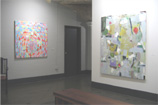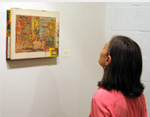
By Subway: By car from Manhattan: |
The Hecla Iron Works Company was one of the most important manufacturers of architectural and ornamental iron and bronze in the United States during the late 19th and early 20th centuries. The firm supplied ornamental work for the exteriors and interiors of some of New York's most beloved buildings, including the American Surety Building, the New York Life Insurance Building and Grand Central Terminal. Hecla was also responsible for fabricating the original IRT subway kiosks, various street clocks (including the one on Broadway between 23rd and 24th Streets), the Lullwater Bridge in Prospect Park and for providing ornamentation for such famous architects as Henry Hardenbergh and the firm of McKim Mead & White. "The Hecla Iron Works company was groundbreaking in its technological advancements in architectural construction. Its building is a wonderful addition to our collection of industrial landmarks." — Robert B. Tierney, Chairperson, Landmarks Preservation Commission Constructed in 1896-97, the Hecla Iron Works building was built to serve as the company's headquarters and showroom, in addition to being a school to train metalworkers and a design studio. The building was designated as the "Hecla Ironworks Patented Octagonal Fireproof Building Design". Niels Poulson, who founded the company with Charles M. Eger in 1876, is likely to have supervised design and construction. It is one of the most significant industrial buildings in Brooklyn, and exhibits the transitional point between traditional masonry construction and the steel-framed curtain wall construction of early skyscraper Inspired by classical sources, the elevations are divided by large and small pilasters, as well as spandrel panels embellished with rosettes and simple moldings. However, what is more significant is the exterior of the building itself, which is an early forerunner of Modernist architecture. The building's fašade is a clear predecessor to the modern curtain wall. By repeating four basic elements - a spandrel, a window, a small pilaster and a large pilaster, the fašade shows with unprecedented honesty the structure of the building. At a time when cast iron facades were emulating stone, the Hecla building's fašade is formal and minimalist. Moreover, it appears as if the original finish of the cast iron fašade was not painted but was allowed to rust as a sealant. This would indicate a progressive treatment of the metal since such a treatment would be later used in Modern steel structures. Lastly, the windows on the Hecla Iron Works building also add to its importance as a precursor to Modernist expression. The multi-paned steel casement windows are extremely rare and indisputably significant, and seem to be some of the oldest extant steel casement windows in New York City. * This text was taken from the statement of the Historic Districts Council made to the Landmarks Preservation Commission--the New York City agency responsible for designating and regulating New York City's landmarks. On June 8, 2004, the LPC granted landmark status to the building. |
|




